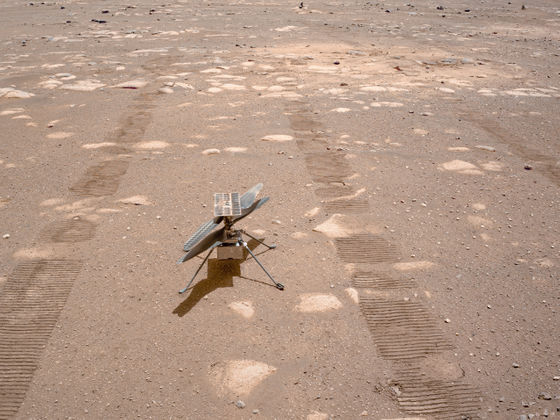Space physicist explains how great the first successful flight of NASA's Mars helicopter is

By NASA / JPL-Caltech
On April 19, 2021, NASA succeeded in flying the unmanned helicopter '
So a helicopter flew on Mars for the first time. A space physicist explains why that's such a big deal
https://theconversation.com/so-a-helicopter-flew-on-mars-for-the-first-time-a-space-physicist-explains-why-thats-such-a-big-deal-159334
On April 19, 2021, local time, the unmanned helicopter Ingenuity onboard Perseverance hovered for 30 seconds at an altitude of 3 meters above the surface of the earth and successfully landed. The first flight of this ingenuity is explained in detail in the following article.
NASA's Mars helicopter successfully flies, the first feat in human history-GIGAZINE

To put it plainly, this first flight can be said to be 'just hovering for 30 seconds', so it seems like a trivial event assuming a flight on Earth. However, according to expert Mr. Isles, 'a feat in the history of human space exploration', Mr. Isles explained how brilliant this event was, 'Why it is difficult to fly a helicopter on Mars. Is it? '
The biggest problem with flying a helicopter on Mars is the atmosphere. A helicopter is a vehicle that flies with lift by rotating the rotor. The presence of the atmosphere is essential to obtain lift, but since the atmosphere on Mars is more than one-hundredth as thin as the Earth, the difficulty of the act of 'flying a helicopter on the surface of Mars' is 'the altitude of the earth.' It is equivalent to 'flying a helicopter at 30,000 meters'. Since the maximum altitude of a helicopter on the earth is 42,000 feet (about 12,800 meters), the helicopter's flight from the surface of Mars was unprecedented even from the viewpoint of the atmosphere.
On the other hand, when considering the difference between Mars and the Earth, the 'gravity' that comes after the atmosphere is actually one-third that of the Earth, so it was actually an advantageous condition for NASA. As a result, NASA struggled with the difficulty of 'thin atmosphere' with 'low gravity' as a tailwind during the first flight of Ingenuity, Isles explained.
To counter these environmental conditions, NASA has made Ingenuity different from Earth's helicopters. Helicopters on Earth fly at 400-500 rpm, but because Ingenuity flies in the thin atmosphere of Mars, the rotor was set at a speed of 2400 rpm. In addition, the ingenuity is 13.6 cm x 19.5 cm x 16.3 cm, which is about the size of a tissue box, but the rotor length is 1.2 m, which is unbalanced and the rotor is designed to be long.

by Kevin Gill
There were also difficulties in the operation to fly, Isles said. In this operation, the signal was delivered to Ingenuity from NASA's PC via satellite antennas, Mars Reconnaissance Orbiter orbiting Mars, and Perseverance. Therefore, the signal emitted from the earth reaches Mars in just a few minutes, but this operation required a large number of relays, so it took 'a few hours'.
In the future, NASA plans to conduct an experiment to 'fly Ingenuity at a position about 300 m away from Perseverance.' These experiments, NASA is in 2019 revealed Isles Mr. and contribute significantly to the goal of 'executing a manned Mars exploration in 2035,' he says.
Related Posts:
in Vehicle, Posted by darkhorse_log






